|
San Diego City and County Designations
September/October 2020
In September, the City of San Diego Historical Resources Board designated six new landmarks and decided not to designate a house designed by Master Architect Lloyd Ruocco due to alterations (6051 Folsom Drive in La Jolla). Five of these new designations occupy the Uptown community and include the former Mission Hills Branch Library. The three other resources are within Bankers Hill, one of the first residential neighborhoods established beyond downtown.
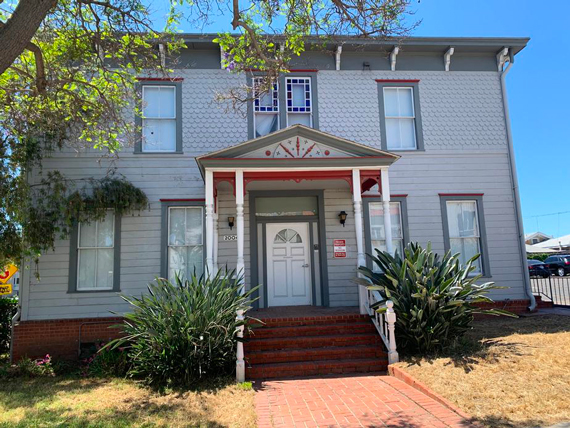 2004 Fourth Avenue in Bankers Hill was constructed c. 1888 in the Italianate style as a carriage house for the Florence Hotel, once located across Grape Street. By 1906, it had been moved to the corner of Fourth Avenue and Grape Street to make room for a spec house at 328 Grape Street. Then it was converted into a single-family home. By 1921, this adaptable building had become apartments, and today it still retains its exterior architectural integrity despite these two changes in use. Designated under Criterion A, this highly unique and unusual resource is significant for the rare historical and architectural development of an early Bankers Hill Italianate style carriage house. Read more about SOHO's effort to ensure the designation 2004 Fourth Avenue HERE. 2004 Fourth Avenue in Bankers Hill was constructed c. 1888 in the Italianate style as a carriage house for the Florence Hotel, once located across Grape Street. By 1906, it had been moved to the corner of Fourth Avenue and Grape Street to make room for a spec house at 328 Grape Street. Then it was converted into a single-family home. By 1921, this adaptable building had become apartments, and today it still retains its exterior architectural integrity despite these two changes in use. Designated under Criterion A, this highly unique and unusual resource is significant for the rare historical and architectural development of an early Bankers Hill Italianate style carriage house. Read more about SOHO's effort to ensure the designation 2004 Fourth Avenue HERE.
|
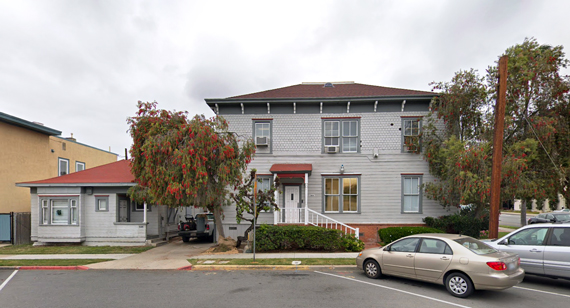 328 Grape Street, Bankers Hill, is a c. 1908 Folk style bungalow with Neoclassical influences. Designated under Criterion C, as an excellent and intact example of the style, features include the pyramidal roof form with its integral front porch, the asymmetrical front facade, a boxed cornice with short eaves, divided-light [add hyphen] wood sash windows, and the prominent multi-window bay. Photo courtesy Google Street View 2018 328 Grape Street, Bankers Hill, is a c. 1908 Folk style bungalow with Neoclassical influences. Designated under Criterion C, as an excellent and intact example of the style, features include the pyramidal roof form with its integral front porch, the asymmetrical front facade, a boxed cornice with short eaves, divided-light [add hyphen] wood sash windows, and the prominent multi-window bay. Photo courtesy Google Street View 2018
|
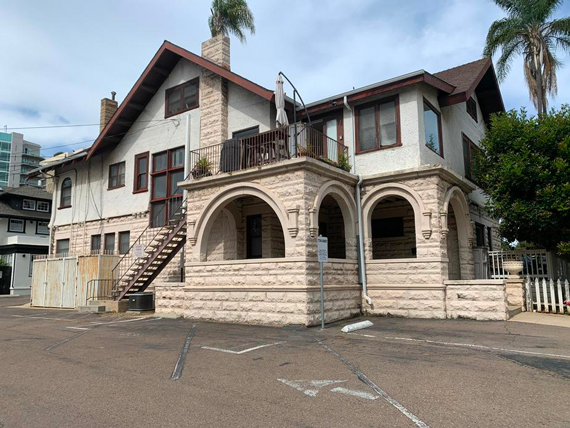 540 Thorn Street in Bankers Hill is a rare and uniquely mixed-style building for San Diego. Prominently sited on a corner across from Balboa Park, and featured on several historic postcards, this exquisite c. 1909 home harmonizes the Tudor Revival, Arts and Crafts era, and Richardsonian Romanesque styles. Designed by Elmer Bayless (an intriguing young designer who warrants further research), this high style resource is designated under Criterion C, as a rare and excellent example of this stylistic blend. Character-defining features of the unique Richardsonian Romanesque style include round arches over porch supports and entries as well as masonry walls with rough-faced, squared stonework. The Tudor Revival style is reflected in the half-timbering within multiple gables, the steeply pitched side-gable roof, wood framed multi-pane glazed windows, and the stone and stucco exterior cladding. Influences of the Arts and Crafts era are seen in the partial width front porch, windows of varying shape and size, and rectangular massing. Read more about SOHO's effort to ensure the designation of 540 Thorn Street HERE. 540 Thorn Street in Bankers Hill is a rare and uniquely mixed-style building for San Diego. Prominently sited on a corner across from Balboa Park, and featured on several historic postcards, this exquisite c. 1909 home harmonizes the Tudor Revival, Arts and Crafts era, and Richardsonian Romanesque styles. Designed by Elmer Bayless (an intriguing young designer who warrants further research), this high style resource is designated under Criterion C, as a rare and excellent example of this stylistic blend. Character-defining features of the unique Richardsonian Romanesque style include round arches over porch supports and entries as well as masonry walls with rough-faced, squared stonework. The Tudor Revival style is reflected in the half-timbering within multiple gables, the steeply pitched side-gable roof, wood framed multi-pane glazed windows, and the stone and stucco exterior cladding. Influences of the Arts and Crafts era are seen in the partial width front porch, windows of varying shape and size, and rectangular massing. Read more about SOHO's effort to ensure the designation of 540 Thorn Street HERE.
|
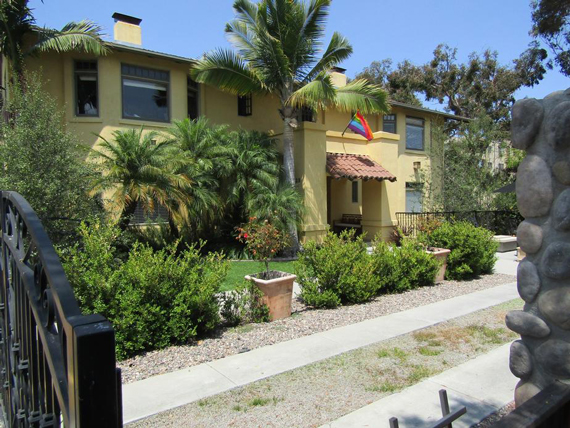 3629 Front Street in the Hillcrest neighborhood of Uptown embodies the Cherokee Apartments, an Arts and Crafts era building with Mission Revival style influences. Constructed in 1913, the Cherokee Apartments are designated under Criterion C for embodying distinct features of the style, which include the side-gable roof, stucco exterior, rhythm of bay windows with wood windows and divided-light transoms, deep eaves with decorative rafter tails, brackets, and an entry portico with stucco piers and shed roof covered in red clay tile. 3629 Front Street in the Hillcrest neighborhood of Uptown embodies the Cherokee Apartments, an Arts and Crafts era building with Mission Revival style influences. Constructed in 1913, the Cherokee Apartments are designated under Criterion C for embodying distinct features of the style, which include the side-gable roof, stucco exterior, rhythm of bay windows with wood windows and divided-light transoms, deep eaves with decorative rafter tails, brackets, and an entry portico with stucco piers and shed roof covered in red clay tile.
|
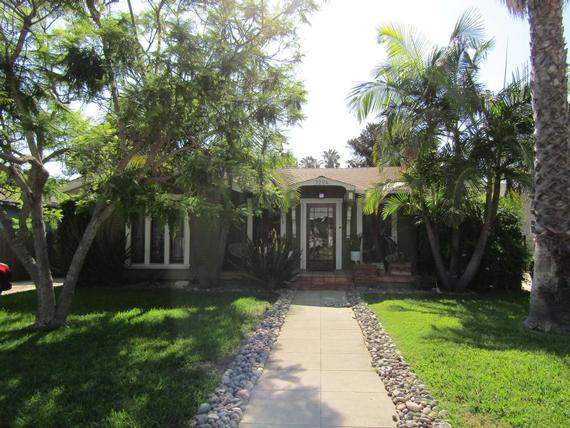 3204 Felton Street in North Park is an Arts and Crafts era resource constructed in 1922. Designated under Criterion C, for its exemplary architectural style, features include the low pitch, cross-gable roof, exposed and painted wood gable beams and rafter tails, clapboard exterior, porch brackets, divided-light wood windows and doors, and much more. 3204 Felton Street in North Park is an Arts and Crafts era resource constructed in 1922. Designated under Criterion C, for its exemplary architectural style, features include the low pitch, cross-gable roof, exposed and painted wood gable beams and rafter tails, clapboard exterior, porch brackets, divided-light wood windows and doors, and much more.
|
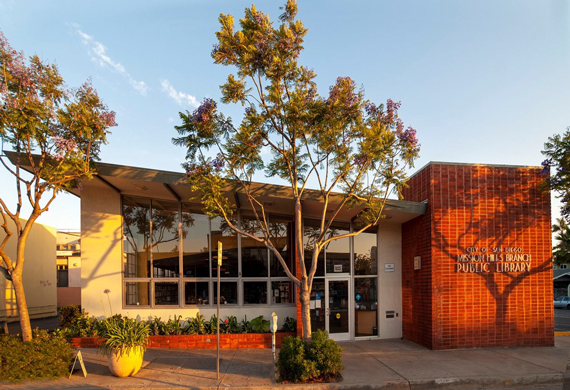 925 West Washington Street in Mission Hills is the former, 1961 Mission Hills Branch Library, constructed in a Mid-Century Contemporary style with Googie-inspired details that include the sweeping shed roof. Designated under Criterion C, as an excellent example of the style, character-defining features include the angular shed roof massing with deep overhanging eaves, large aluminum-framed windows, and exterior cladding composed of stucco and stacked brick. Mission Hills Heritage nominated this community landmark. Photo by Dan Soderberg 925 West Washington Street in Mission Hills is the former, 1961 Mission Hills Branch Library, constructed in a Mid-Century Contemporary style with Googie-inspired details that include the sweeping shed roof. Designated under Criterion C, as an excellent example of the style, character-defining features include the angular shed roof massing with deep overhanging eaves, large aluminum-framed windows, and exterior cladding composed of stucco and stacked brick. Mission Hills Heritage nominated this community landmark. Photo by Dan Soderberg
|
In October, the Historical Resources Board designated six new resources, one being less than 45 years old, as well as naming a new Master Architect, Frederick Leibhardt. Staff explained the new online option to discuss projects with historical resources staff (https://www.sandiego.gov/development-services/virtual-appointments). They also gave a brief presentation for Archaeology Month, and said the City will be hiring a new senior historic planner and a junior one soon.
Further, the Planning Department staff reported that their work on the Park Villas Historic District in North Park has determined it is not eligible for designation due to a loss of integrity, and will be brought to the Board for discussion as an informational item soon. Planning staff is still processing the Culverwell and Taggarts Historical District in Golden Hill, also on their 2020 work plan, but the pandemic has slowed their progress.
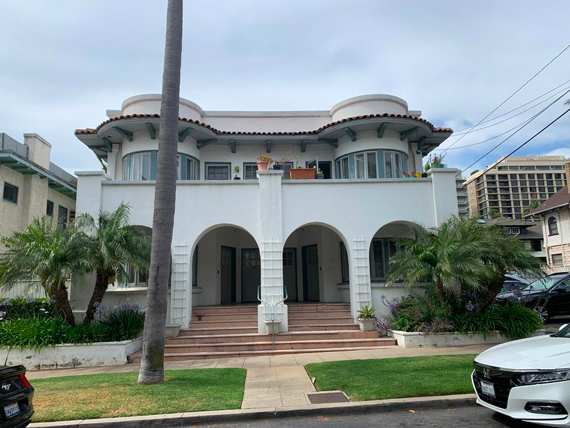 516-522 Thorn Street in the Bankers Hill community of Uptown is a unique Mission Revival style apartment building with Italian Renaissance influences. Constructed in 1913 and composed of hollow clay tiles, significant features include the two-story bay windows, arched entry facade, rounded parapet with clay tile shed roof, and casement windows. Designated under Criterion C, for exemplary architecture, this is an outstanding local example designed by a contractor named William Burney Johnson. 516-522 Thorn Street in the Bankers Hill community of Uptown is a unique Mission Revival style apartment building with Italian Renaissance influences. Constructed in 1913 and composed of hollow clay tiles, significant features include the two-story bay windows, arched entry facade, rounded parapet with clay tile shed roof, and casement windows. Designated under Criterion C, for exemplary architecture, this is an outstanding local example designed by a contractor named William Burney Johnson.
|
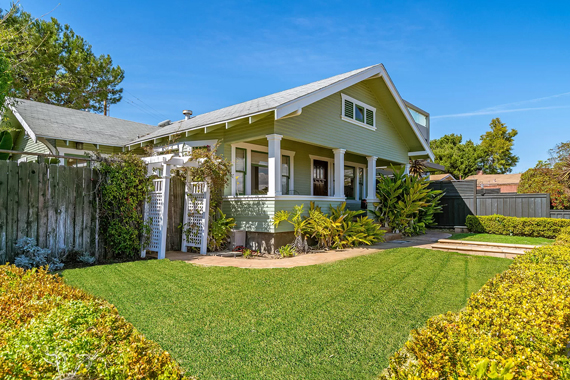 4374 Georgia Street in North Park is a c. 1913 Arts and Crafts era bungalow. Significant under Criterion C, as a good example of the style, character-defining features include the low pitch gable roof, exposed rafter tails and roof members, wide overhanging eaves, wood clapboard siding, a full width front porch, sash and transom wood windows, and the wood entry door. Photo courtesy Zillow 4374 Georgia Street in North Park is a c. 1913 Arts and Crafts era bungalow. Significant under Criterion C, as a good example of the style, character-defining features include the low pitch gable roof, exposed rafter tails and roof members, wide overhanging eaves, wood clapboard siding, a full width front porch, sash and transom wood windows, and the wood entry door. Photo courtesy Zillow
|
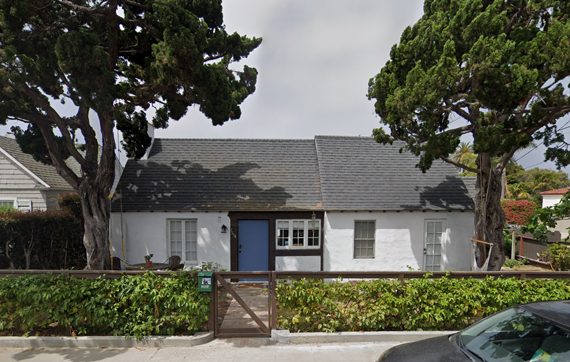 7154 Olivetas Avenue in La Jolla is designed in the Tudor Revival style by Master Designer Florence Palmer. Constructed in 1927, original characteristics of the home are the single-story massing with high-pitch roof and exposed wood rafter tails, exterior stucco finish, decorative half-timbering, and wood sash and divided-lite casement windows. Designated under Criteria C and D, for its stylistic integrity and the Master Designer, this is one of Palmer's earliest works and represents her independence as a female designer. Photo courtesy Google Street View 7154 Olivetas Avenue in La Jolla is designed in the Tudor Revival style by Master Designer Florence Palmer. Constructed in 1927, original characteristics of the home are the single-story massing with high-pitch roof and exposed wood rafter tails, exterior stucco finish, decorative half-timbering, and wood sash and divided-lite casement windows. Designated under Criteria C and D, for its stylistic integrity and the Master Designer, this is one of Palmer's earliest works and represents her independence as a female designer. Photo courtesy Google Street View
|
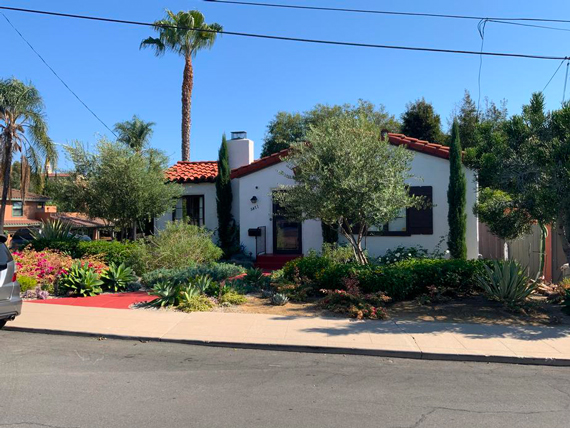 5471 Madison Avenue in the College Area neighborhood, c. 1931, illustrates the Spanish Eclectic style. Significant under Criterion C for architecture, features include the asymmetrical massing, smooth stucco exterior, a low pitch cross-gable roof clad in red clay tiles as well as a parapet wall, exposed wood rafter tails, a large arched focal window, and wood sash and divided-light casement windows. 5471 Madison Avenue in the College Area neighborhood, c. 1931, illustrates the Spanish Eclectic style. Significant under Criterion C for architecture, features include the asymmetrical massing, smooth stucco exterior, a low pitch cross-gable roof clad in red clay tiles as well as a parapet wall, exposed wood rafter tails, a large arched focal window, and wood sash and divided-light casement windows.
|
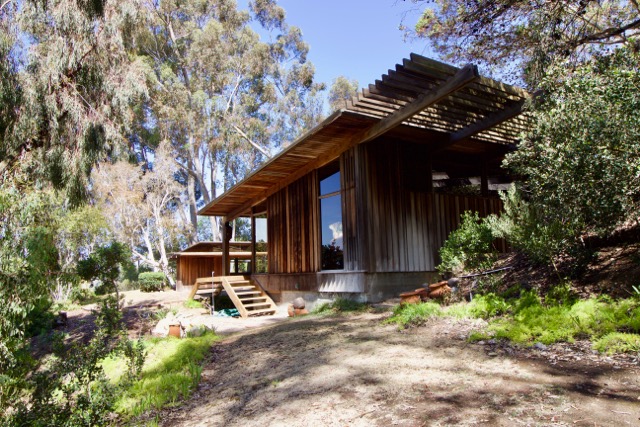 7224 Carrizo Drive in La Jolla, was constructed in 1959 as the home of the newly designated Master Architect Frank Leibhardt, and features the Organic Geometric style and a 1969 Post and Beam style addition he also designed. Significant under Criterion C for its unique architecture, character-defining features include the asymmetrical facade, angular massing, a strong connection between the interior and exterior, harmony with the site, deep overhanging eaves, and the use of natural materials such as board and batten wood siding, battered concrete walls and large stone aggregate, which is reminiscent of designs by Frank Lloyd Wright. Frederick and his wife, Marianne, who studied interior design, selected and set individual rocks to form prominent walls and walkways. Also significant under Criterion D, Leibhardt, unlike many other Mid Century architects, is unique to San Diego because of his prior experience gained with Frank Lloyd Wright as a Taliesin apprentice and working under Master Architect Lloyd Ruocco while living on Carrizo Drive, which helped Liebhardt to develop the high quality design and aesthetic presented here. Photo courtesy Johnson & Johnson Architecture 7224 Carrizo Drive in La Jolla, was constructed in 1959 as the home of the newly designated Master Architect Frank Leibhardt, and features the Organic Geometric style and a 1969 Post and Beam style addition he also designed. Significant under Criterion C for its unique architecture, character-defining features include the asymmetrical facade, angular massing, a strong connection between the interior and exterior, harmony with the site, deep overhanging eaves, and the use of natural materials such as board and batten wood siding, battered concrete walls and large stone aggregate, which is reminiscent of designs by Frank Lloyd Wright. Frederick and his wife, Marianne, who studied interior design, selected and set individual rocks to form prominent walls and walkways. Also significant under Criterion D, Leibhardt, unlike many other Mid Century architects, is unique to San Diego because of his prior experience gained with Frank Lloyd Wright as a Taliesin apprentice and working under Master Architect Lloyd Ruocco while living on Carrizo Drive, which helped Liebhardt to develop the high quality design and aesthetic presented here. Photo courtesy Johnson & Johnson Architecture
|
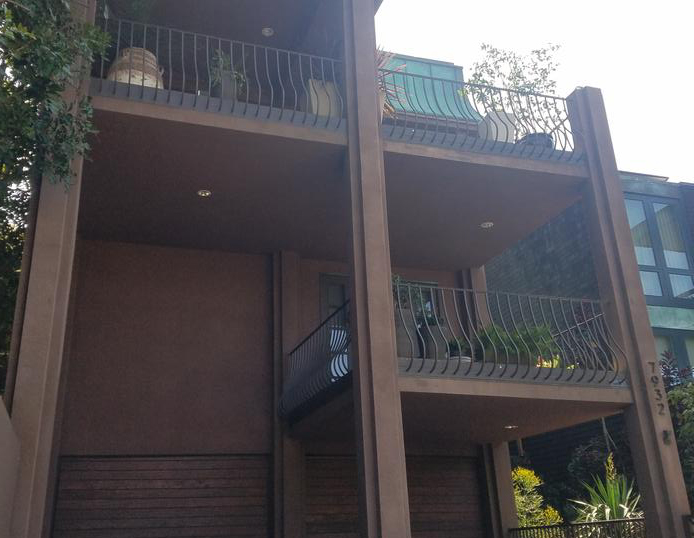 7932 Prospect Place in La Jolla illustrates the rare Post-Modern, Neoecletic French Mansard style. Designed specifically for Helen Copley in 1987, Master Architect Henry Hester came out of retirement specifically for this masterpiece, which is his only design in this style and may be considered the culmination of his career. Designated under Criteria C and D, for its rare style and for being the notable work of Master Hester, character-defining features include the Mansard roof, which was a client request, as well as the "through the cornice windows" and balconies with wrought iron railings. 7932 Prospect Place in La Jolla illustrates the rare Post-Modern, Neoecletic French Mansard style. Designed specifically for Helen Copley in 1987, Master Architect Henry Hester came out of retirement specifically for this masterpiece, which is his only design in this style and may be considered the culmination of his career. Designated under Criteria C and D, for its rare style and for being the notable work of Master Hester, character-defining features include the Mansard roof, which was a client request, as well as the "through the cornice windows" and balconies with wrought iron railings.
|
Notable Resources Not Designated
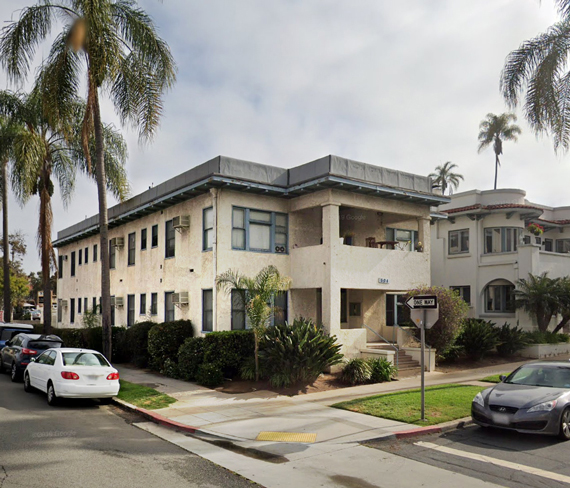 504 Thorn Street in Bankers Hill shares the same parcel as the unique, just designated Mission Revival style apartment building at 516-522 Thorn Street. The HRB asked previously for more information about alterations to this building. The additional information led the board to decide too many changes degraded the building's integrity and it was not designated. Photo courtesy Google Street View 504 Thorn Street in Bankers Hill shares the same parcel as the unique, just designated Mission Revival style apartment building at 516-522 Thorn Street. The HRB asked previously for more information about alterations to this building. The additional information led the board to decide too many changes degraded the building's integrity and it was not designated. Photo courtesy Google Street View
|
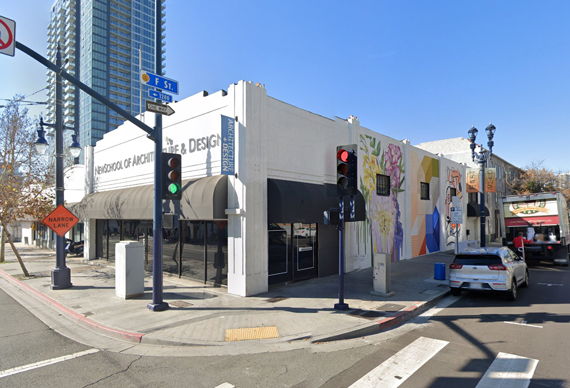 770 Twelfth Avenue in the East Village was withdrawn from the October agenda. However, with Staff support, if this resource nomination returns to the HRB, SOHO will support staff findings of significance under Criterion C as a good commercial example of the Art Deco style. Photo courtesy Google Street View 770 Twelfth Avenue in the East Village was withdrawn from the October agenda. However, with Staff support, if this resource nomination returns to the HRB, SOHO will support staff findings of significance under Criterion C as a good commercial example of the Art Deco style. Photo courtesy Google Street View
|
All photos are from the California Historical Resources Inventory Database (CHRID), except where noted otherwise. The above designations were reviewed and approved by the City of San Diego Historical Resources Board (HRB) or the County of San Diego Historic Site Board (HSB).
|
2025
2024
2023
2022
2021
2020
2019
2018
2017
2016
2015
|

















